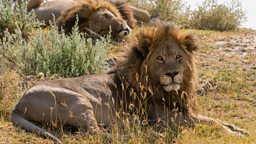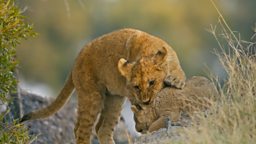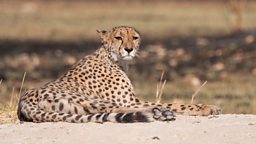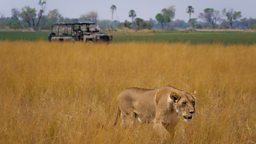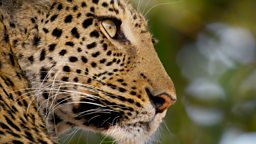Cat spotlight: Xudum the leopard

As part of Big Cats 24/7, I was tasked with leading the leopard team; a daunting prospect as leopards are particularly difficult to keep track of.
the trials and tribulations of a young female trying to start a family
You may know an individual well, but this does not leave you with any certainty of spending good time with them, let alone being able to capture parts of their secretive life and hunting behaviour.
For this series we chose to follow Xudum, a young female of 5 years whose territory pivots from our film camp. I had first met her as a cub of 8 months old, and in the years since, she has only tried to have one litter of her own. Like most young and inexperienced leopard mothers, she unfortunately lost those cubs early on, and my hope was that she was ready to try again while we were filming Big Cats 24/7.
This was the ambition - to follow the trials and tribulations of a young female trying to start a family.

There were also great ambitions to capture the extraordinary hunting behaviour that is quite specific to Okavango leopards - spectacular aerial tree jumping.
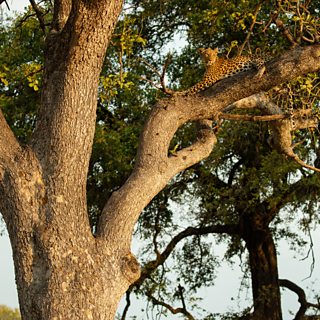
We’d never captured Xudum attempting a jump before
Here African ebonies with fruits, and kigelia trees with their prolific succulent flowers draw in impala herds to feed on them in an otherwise nutrient deficient landscape.
Many of the Okavango’s leopards have picked up on this pattern of behaviour, have learnt to position carefully in the canopy and will jump from great heights onto unsuspecting impalas. It’s probably the most extreme and dramatic behaviour that any big cat could exhibit.
Being a young female, and new to the dynamics of the leopard world, Xudum’s territory was not the best suited for raising a family. It was a great hunting environment, full of ebony and kigelia trees, but it was also an area of massive territory overlap between multiple male leopards. With an uncertainty of dominance in this area, no male was completely secure and in these situations infanticide from male leopards becomes common practice.
More leopards are killed by other leopards than anything else and it’s the cubs that are targeted the most. Xudum lives in an area like this, but as the closest female to our camp she was still undoubtably the best placed leopard for us to track and follow.
Like clockwork the ebonies fruited and they drew in the focussed impala herds. We’d never captured Xudum attempting a jump before, and there was a question of whether she had the experience to do it. This behaviour is not exhibited by all female leopards in the Okavango and usually it’s the older and more experienced ones that have learned to do it.
One thing she had going for her is her size as jumping is almost exclusively reserved for female leopards who have a lighter frame. Xudum is a slight leopard, ideally built for this and she soon began showing serious intent.
For weeks we followed her as she moved from tree to tree, up one, down the next. At times she had a whole herd of impalas right below her, but never jumped. There was a definite uncertainty and hesitation lingering in her strategy. We had doubts as to whether she could master this skill.
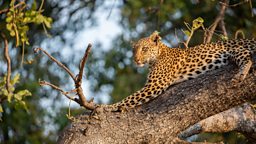
Frustrated, we persisted as Xudum drifted away from this behaviour and became a more normal leopard in terms of her hunting strategy. During this time the ebony trees lost their fruit for the year and we had given up hope in capturing a successful jump, until one morning we found her already treed in a flowering kigelia.
our young female had evolved into one of the unique tree jumping leopards of the Okavango
Cameraman Tristen and I joked about how much time we spent waiting for Xudum to jump. Would this be another anticlimax?
As we settled in a herd of impalas moved straight underneath, and in less than half an hour of finding her she had launched into the herd and caught one. No hesitation, no delay, she committed just as the herd was arriving. I guess sometimes it’s best not overthink it- for her and us - just launching in instinctually and getting it done.
And our instincts allowed us to capture a great sequence. Xudum, our young female, had evolved into one of the few tree jumping leopards of the Okavango! It was a great moment, and like a proud Dad I was completely shocked at how flawlessly we all executed it. We were all puffed up like little robins.

Soon after this, Xudum started mating with a male we know as Boi. Boi means shy in the local language, and that he was. Visions of a prolonged mating and a great behavioural visual sequence were quashed.
all we could do was wait it out for the next 100 days
Another worry was that Boi was not a very dominant male in the area, and certainly not one that had any permanent territory here. He was more of a vagrant male we saw from time to time, and whether she could or would conceive from this encounter was uncertain.
It was impossible to know if the seed was sown and all we could do was wait it out for the next 100 days. Leopards do not show any signs of pregnancy, either visually or behaviourally, until a week or so before giving birth. And even if she was pregnant, there was uncertainty as to whether we’d find her den or if her litter could survive in a territory like hers. Only time would tell.

it’s about timing and endless patience
Filming leopards is always a slow burn; it’s about timing and endless patience and it often feels like drip torture waiting for moments of behaviour to play out. You have to pace yourself. Xudum was our star, and we needed to see this through. Patience and tenacity was the name of the game for us, and whilst what played out in the weeks to come was harrowing, it was certainly worth the wait.
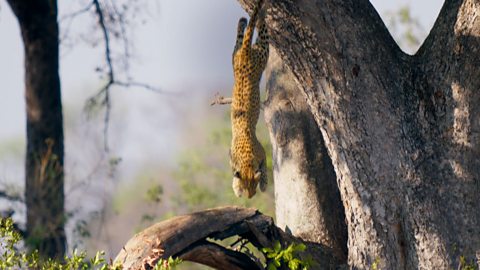
A leopard jumps from the tree tops
Xudum the female leopard leaps from a high tree branch to land on her impala prey.
